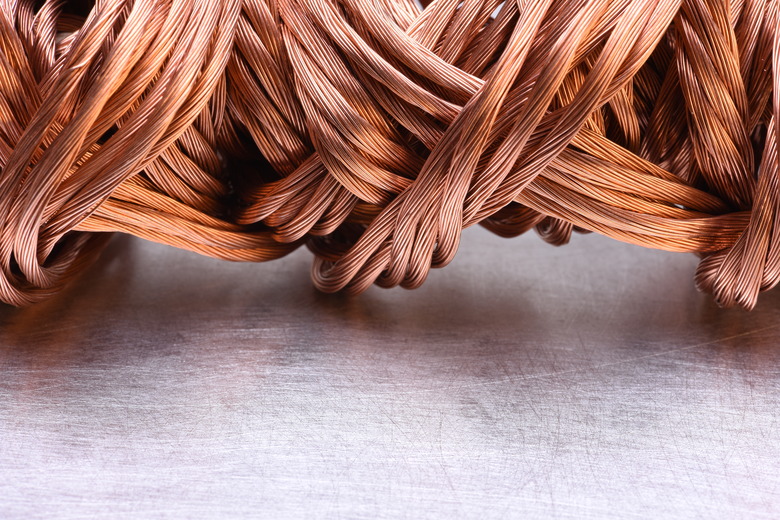How To Determine Conductivity In Compounds
Compounds that conduct a current are held together by electrostatic forces or attraction. They contain a positively charged atom or molecule, called a cation, and a negatively charged atom or molecule, called an anion. In their solid state, these compounds do not conduct electricity, but when dissolved in water, the ions dissociate and can conduct a current. At high temperatures, when these compounds become liquid, the cations and anions begin to flow and can conduct electricity even in the absence of water. Nonionic compounds, or compounds that do not dissociate into ions, do not conduct a current. You can construct a simple circuit with a light bulb as an indicator to test the conductivity of aqueous compounds. The test compound in this setup will complete the circuit and turn on the light bulb if it can conduct a current.
Compounds with Strong Conductivity
Compounds with Strong Conductivity
The easiest way to determine whether a compound can conduct a current is to identify its molecular structure or composition. Compounds with strong conductivity dissociate completely into charged atoms or molecules, or ions, when dissolved in water. These ions can move and carry a current effectively. The higher the concentration of ions, the greater the conductivity. Table salt, or sodium chloride, is an example of a compound with strong conductivity. It dissociates into positively charged sodium and negatively charged chlorine ions in water. Ammonium sulfate, calcium chloride, hydrochloric acid, sodium hydroxide, sodium phosphate and zinc nitrate are other examples of compounds with strong conductivity, also known as strong electrolytes. Strong electrolytes tend to be inorganic compounds, meaning that they lack carbon atoms. Organic compounds, or carbon-containing compounds, are often weak electrolytes or are nonconductive.
Compounds with Weak Conductivity
Compounds with Weak Conductivity
Compounds that dissociate only partially in water are weak electrolytes and poor conductors of an electric current. Acetic acid, the compound present in vinegar, is a weak electrolyte because it dissociates only slightly in water. Ammonium hydroxide is another example of a compound with weak conductivity. When solvents other than water are used, the ionic dissociation, and therefore the capability to carry current, is changed. Ionization of weak electrolytes usually increases with increases in temperature. To compare the conductivity of different compounds in water, scientists use specific conductance. The specific conductance is a measure of the conductivity of a compound in water at a specific temperature, usually 25 degrees Celsius. Specific conductance is measured in units of siemens or microsiemens per centimeter. The degree of water pollution can be determined by measuring the specific conductance, because polluted water contains more ions and can can generate more conductance.
Nonconducting Compounds
Nonconducting Compounds
Compounds that do not produce ions in water cannot conduct an electrical current. Sugar, or sucrose, is an example of a compound that dissolves in water but does not produce ions. The dissolved sucrose molecules are surrounded by clusters of water molecules and are said to be 'hydrated' but remain uncharged. Compounds that are not soluble in water, such as calcium carbonate, also do not have conductivity: they produce no ions. Conductivity requires the existence of charged particles.
Conductivity of Metals
Conductivity of Metals
Electrical conductivity requires the movement of charged particles. In the case of electrolytes or liquefied or molten ionic compounds, positively and negatively charged particles are generated and can move around. In metals, positive metal ions are arranged in a rigid lattice or crystal structure that cannot move. But the positive metal atoms are surrounded by clouds of electrons that are free to roam around and can carry an electrical current. A rise in temperature causes a decrease in electrical conductivity, which contrasts with the increase in conductivity by electrolytes under similar circumstances.
Cite This Article
MLA
Blue, Marie-Luise. "How To Determine Conductivity In Compounds" sciencing.com, https://www.sciencing.com/determine-conductivity-compounds-6069343/. 13 March 2018.
APA
Blue, Marie-Luise. (2018, March 13). How To Determine Conductivity In Compounds. sciencing.com. Retrieved from https://www.sciencing.com/determine-conductivity-compounds-6069343/
Chicago
Blue, Marie-Luise. How To Determine Conductivity In Compounds last modified March 24, 2022. https://www.sciencing.com/determine-conductivity-compounds-6069343/
